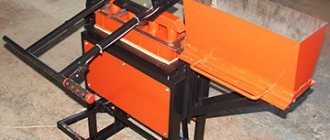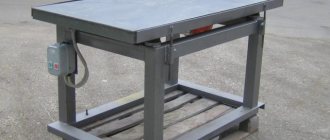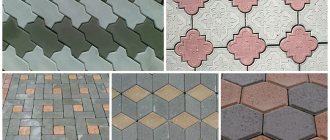Do-it-yourself vibropress
Over the past few years, the use of building blocks made from various mixtures of concrete with lightweight aggregates has become very popular. Wall material has always been expensive, and today you have to count every penny even more so. That is why developers are in no hurry to line up for ready-made cinder blocks, paving slabs and other materials that are made using relatively simple methods. Everyone is trying to save money, and as a result, a whole movement of people who like to pour concrete blocks on their own has appeared.
Engine selection
A vibration motor or factory-made electric motor is fixed on the tabletop, which allows you to create the necessary vibration.
No less popular is the use of a kinematic scheme, in which the engine is fixed to the frame.
In this case, it is assumed that a V-belt drive will be used.
The most popular and convenient option, from an operational point of view, is to equip a vibrating table for the production of paving slabs with an electric motor and then attach the eccentric to the shaft. A special imbalance must be fixed to the clamp, which is located on the shaft.
It is very convenient to use a fairly heavy and massive bolt as an imbalance, with the help of which the vibration force is regulated in the process of screwing on a certain number of nuts.
If you are interested in the technological process of making paving slabs, read the article.
An overview of plastic tile options and their costs is presented here.
Vibropress for blocks
For the production of concrete blocks, paving slabs, cinder blocks and expanded clay concrete blocks, one single main device is used - a brick press. Having a brick making press on your farm, you can stamp blocks in an unlimited quantity, providing both your own construction and the opportunity to sell some of the unused material, and if the brick making press is productive and of high quality, then you can even open a small business. But this is in the future, but for now let’s figure out what kind of brick making machine this is, why it is needed, what it’s made of, and what’s the point of assembling a brick making press with your own hands.
Machines for the production of pressed blocks can differ greatly in many respects:
All this greatly influences the choice of device for producing blocks or tiles. No one has ever classified these machines, but conditionally, guided by sound logic, they can be divided into several categories.
Vibration press operation
To put a machine (vibropress) for paving slabs into operation, just follow a few simple steps.
Technology for creating tiles using vibration pressing:
- The matrix is lubricated with oil.
- Pour the mixture into the mold and place it on the countertop so that the punch exactly matches the matrix.
- The mixture is pressed into the mold using a lever and at the same moment the vibration motor is briefly turned on.
- The product is removed from the matrix for drying and curing.
The composition of the mixture for paving slabs on a brick press is determined based on the desired characteristics of the final product. Typically the composition includes sand, cement, water, crushed stone screenings, and pigment.
Creating a brick press for paving slabs with your own hands is a completely doable task. If you have the optimal drawing, electric welding and all the necessary parts, assembling a high-quality and reliable machine will not be difficult.
Vibropress for tiles
All brick making machines can again be conditionally divided into several categories based on the size of the forming zone. That is, roughly speaking, what kind of products can be produced on such a brick press. The smallest and medium ones are suitable for making paving slabs and small borders. The maximum size of their forming zone is no more than 0.3 m². Therefore, they can only produce tiles. As a rule, they all involve manual selection of the finished product, which dictates the maximum load weight that one person can handle. This is no more than 35 kg.
Each of the brick making machines for paving slabs has its own performance indicators and speed of formation of the loading cycle. The fastest of them form a block in 8-10 seconds, and the time it takes to form a block with handicraft machines is two to three minutes. Consequently, productivity is very different, and mass production of tiles using such equipment is out of the question.
Workflow Stages
The most important thing that experts recommend starting the work process with is making detailed drawings of the future press.
Homemade vibropress for paving slabs
Now, according to the drawings, it is necessary to gradually manufacture each part of the future machine:
- Legs. To work, you need to purchase a number 10 channel and a pipe from 80 to 100 mm in diameter. Using a grinder, 4 pieces of the required length are cut. We must not forget about trimming all the edges of the workpieces. When making a stationary machine, an allowance of 26 mm must be made to the length of the legs. This is necessary in order to be able to bury the legs of the brick making machine into the base. If the equipment is of a portable type, then parking plates must be welded to the lower edges of the legs. This will make the machine more stable. For their manufacture, steel 3 mm thick is used.
- Frame. The upper part of the frame is made of channel and I-beam. All parts of the frame are cut out using a grinder and placed on a flat, horizontal surface. This is necessary in order to be able to quickly weld all parts of the workpieces together. After completing the welding work, all seams are thoroughly cleaned and coated with a special paint that has anti-corrosion properties.
- Tabletop. This part must be stable and durable. For this purpose, transverse struts are used. The tabletop frame and spacers are made using angle-type steel. Recommended material size 70 mm. The shape and dimensions of the tabletop frame should be similar to the same frame parameters. If there is a difference in the above parameters, it should not exceed 7 cm. After cutting the workpieces with a grinder and cleaning the edges of their cuts, they are laid out on a flat plane. After welding all the workpieces and cleaning the welding seams, a rectangular workpiece is cut to the size of the frame. For this purpose, sheet steel 8 - 10 mm thick is used. The rectangle is placed on the top of the frame and welded to it.
The use of steel as a working material ensures the strength and stability of the concrete block press during operation. This is a necessary condition, since during operation the equipment experiences quite strong vibration.
Specifics of production of building blocks by vibrocompression
A brick press is a device that uses the principle of forming products using a vibrator by creating excess pressure (“load”).
Vibrocompression involves the use of a rigid concrete mixture, which contributes to the production of the most strong, durable and reliable products. Since this technology uses a “weight”, it becomes possible to use coarse aggregates, including materials that are waste from various industries. The use of expanded clay, slag, sawdust, broken bricks, and screenings reduces the cost of manufacturing building blocks. A brick making press involves the use of a rigid matrix, due to which the geometric dimensions of the blocks are more repeatable, which has a positive effect on the speed and quality of construction of load-bearing structures.
Sequence of operations when using vibration compacting equipment:
Since the working process is accompanied by high pressure on the mixture, various materials, including coarse-grained ones, can be used as fillers
The general scheme for making cinder blocks looks simple, but in reality a brick making press is a rather complex device in which all elements must be balanced, since they are forced to work under significant loads and vibrations.
Design Features
The performance of the vibrating platform and the geometry of the finished products depend on the equipment. One of the main elements is the matrix, which is a steel box without a bottom. The matrix is installed on a pallet or on the surface of the extruder. Many models involve the use of the floor as a formative element. A punch is mounted above the matrix, driven by an electric motor, hydraulic drive, or manually using a lever block. The shape of the plane of the punch that exerts pressure on the solution must correspond to the geometry of the front part of the product.
Classification of brick making machines
Vibration equipment for the production of blocks is manufactured by many large companies and small firms, many of which introduce a number of improvements to the design, which makes a clear classification of these devices difficult.
However, based on a number of criteria, it is possible to identify the main classes of brick making machines.
Mobile brick making machines are well suited for warm climate zones where they can be operated outdoors
By type of formation of block products:
The bed of a mobile concrete block press with the help of a wheeled chassis makes it possible to form cinder blocks directly on the surface of the construction site, which becomes part of its structure. In mobile vibrating machines, which are popularly called “laying hens,” the matrix, on which the punch presses, is pressed directly to the floor. After completing the manufacturing cycle, the matrix rises, leaving the manufactured product on the surface, moves to the required distance, and the process is repeated.
A typical mobile vibrating machine is characterized by relatively small dimensions and weight; it can be used directly at the construction site. There is no need to transport the blocks, but the requirement remains to dry the products under natural conditions, which takes some time.
Mobile brick making machines are subject to a number of requirements that narrow their scope of application:
Depending on the tasks assigned to the brick making machine, the design of this machine may differ significantly
Stationary vibropressing equipment is characterized by large dimensions, allowing it to achieve high productivity. Typically, such brick making machines have extensive functionality that simplifies the production of final products through the use of a range of various additional equipment.
Structurally stationary vibrating machines are divided into devices that use pallets and those that do without it. Vibropress machines with a pallet, which is the formative element of the unit, are considered more universal. They are characterized by fewer restrictions on use (the only drawback of vibrating machines with pallets is the need to have a sufficient supply of pallets of the required configuration).
Based on the type of drive, vibrocompression machines are divided into devices with:
To organize production and achieve full productivity, it is necessary to have large production areas
In manually driven designs, excess pressure is created using muscular force using a system of levers. It is precisely these machines that are popular when manufactured independently, but they have a significant drawback: limited assortment. Other factors limiting the use of manually driven vibropresses are considered to be insufficient quality of products (due to the inability to achieve the required compaction of the mixture), as well as heavy physical stress on operating personnel.
The most common devices are hydraulically driven, but this type of machine is quite expensive. Machines with electromechanical drives are more affordable, but are characterized by lower productivity and do not allow for complete automation of the process.
How to make a tabletop
The tabletop, which takes on a significant part of the workload, must be manufactured with an emphasis on rigidity and structural strength. Based on this, the frame of this element must be made not only from perimeter parts. The frame will also require cross braces. The format of the frame of the table top, made of angle steel seventy by seventy millimeters, must completely coincide with the format of the frame. In this case, the dimensions of the entire tabletop should exceed the dimensions of the frame by no more than seven centimeters.
The workpiece elements must be laid out horizontally, after which they are fastened by welding. Here, too, you will have to grind and clean all the welding seams. Next, you need to cut a rectangle from eight to ten millimeters thick sheet steel that matches the dimensions of the frame. This rectangle needs to be placed on the frame and welded on the bottom.











